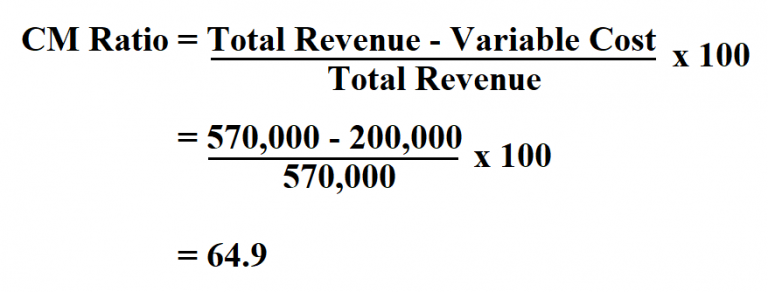
The contribution margin (CM) is the profit generated once variable costs have been deducted from revenue. Investors and analysts use the contribution margin to evaluate how efficient the company is at making profits. For example, analysts can calculate the margin per unit sold and use forecast estimates for the upcoming year to calculate the forecasted profit of the company. Net sales are basically total sales less any returns or allowances. This is the net amount that the company expects to receive from its total sales. Some income statements report net sales as the only sales figure, while others actually report total sales and make deductions for returns and allowances.
Step 2 of 3
Keep in mind that contribution margin per sale first contributes to meeting fixed costs and then to profit. The contribution margin shows how much additional revenue is generated by making each additional unit of a product after the playbook raises $3m to help fitness instructors monetize through remote workouts company has reached the breakeven point. In other words, it measures how much money each additional sale “contributes” to the company’s total profits. To cover the company’s fixed cost, this portion of the revenue is available.
Business Cards
Fixed and variable costs are expenses your company accrues from operating the business. In effect, the process can be more difficult in comparison to a quick calculation of gross profit and the gross margin using the income statement, yet is worthwhile in terms of deriving product-level insights. For a quick example to illustrate the concept, suppose there is an e-commerce retailer selling t-shirts online for $25.00 with variable costs of $10.00 per unit.

How can a business increase its Contribution Margin Ratio?
It may turn out to be negative if the variable cost is more that the revenue can cover. The contribution margin ratio of a business is the total revenue of the business minus the variable costs, divided by the revenue. It also results in a contribution margin ratio of $14/$20, or 70%.
Unit Contribution Margin
The first step to calculate the contribution margin is to determine the net sales of your business. Net sales refer to the total revenue your business generates as a result of selling its goods or services. Dobson Books Company sells textbook sets to primary and high schools. In the past year, he sold $200,000 worth of textbook sets that had a total variable cost of $80,000. Thus, Dobson Books Company suffered a loss of $30,000 during the previous year.
Calculate Contribution Margin Ratio
All of these new trends result in changes in the composition of fixed and variable costs for a company and it is this composition that helps determine a company’s profit. The contribution margin subtracts the variable costs for producing a single product from revenue. The contribution margin measures the profitability of individual items that a company makes and sells. This margin reviews the variable costs included in the production cost and a per-item profit metric, whereas gross margin is a company’s total profit metric. Direct production costs are the cost of goods sold (COGS) and include raw materials, labor, and overhead attributed to each product.
Decisions can be taken regarding new product launch or to discontinue the production and sale of goods that are no longer profitable or has lost its importance in the market. The contribution margin ratio refers to the difference between your sales and variable expenses expressed as a percentage. That is, this ratio calculates the percentage of the contribution margin compared to your company’s net sales. Say, your business manufactures 100 units of umbrellas incurring a total variable cost of $500. Accordingly, the Contribution Margin Per Unit of Umbrella would be as follows.
- All of these new trends result in changes in the composition of fixed and variable costs for a company and it is this composition that helps determine a company’s profit.
- 11 Financial may only transact business in those states in which it is registered, or qualifies for an exemption or exclusion from registration requirements.
- Direct Costs are the costs that can be directly identified or allocated to your products.
- Many companies use metrics like the contribution margin and the contribution margin ratio to help decide if they should keep selling various products and services.
Variable Costs depend on the amount of production that your business generates. Accordingly, these costs increase with the increase in the level of your production and vice-versa. This means the higher the contribution, the more is the increase in profit or reduction of loss. In other words, your contribution margin increases with the sale of each of your products. In summary, the contribution margin provides valuable insights into the financial health of a company and supports decision-making regarding product portfolio, pricing strategies and cost efficiency. They can use that information to determine whether the company prices its products accurately or is likely to turn a profit without looking at that company’s balance sheet or other financial information.
The benefit of expressing the contribution margin as a percentage is that it allows you to more easily compare which products are the most valuable to your business. Profits will equal the number of units sold in excess of 3,000 units multiplied by the unit contribution margin. We explain its formula, differences with gross margin, calculator, along with example and analysis. You may also look at the following articles to enhance your financial skills. Now, let’s try to understand the contribution margin per unit with the help of an example. As you can see, the contribution margin per-unit remains the same.
Regardless of how contribution margin is expressed, it provides critical information for managers. Understanding how each product, good, or service contributes to the organization’s profitability allows managers to make decisions such as which product lines they should expand or which might be discontinued. When allocating scarce resources, the contribution margin will help them focus on those products or services with the highest margin, thereby maximizing profits.
By determining the contribution margin, a company can determine which products are profitable and which are not. Contribution margins are often compared to gross profit margins, but they differ. Gross profit margin is the difference between your sales revenue and the cost of goods sold. Crucial to understanding contribution margin are fixed costs and variable costs. You pay fixed expenses regardless of how much you produce or sell.

